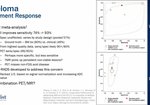10 seconds
Playback speed
IOTA Terms and Definitions: How Should You Describe an Adnexal Mass?
This video forms part of the ISUOG Advanced Training Curriculum course, for more information visit the ISUOG website:
Ovarian cancer part 1 - Ultrasound, IOTA methods and O-RADS
Ovarian cancer is relatively rare but remains one of the most lethal gynecologic cancers due to its often late diagnosis. Globally, ovarian cancer is the eighth most common cancer in women, with approximately 300,000 new cases reported annually (according to WHO and GLOBOCAN). The disease typically affects women over the age of 50, although it can occur at any age. Due to its nonspecific symptoms and lack of effective early screening, ovarian cancer is frequently diagnosed at an advanced stage, contributing to its high mortality rate.
In the full course, available here, we will learn to identify and describe the common ultrasound features specific to ovarian physiology. We will discuss how to appropriately describe adnexal masses by using the International Ovarian Tumor Analysis (IOTA) group terminology. Subsequently, we will apply ultrasound features to discriminate between benign and malignant adnexal masses, including using the features of IOTA prediction methods (Simple ultrasound based rules; Modified benign descriptors (MBDs); Assessment of Different Neoplasias in the AdneXa (ADNEX); Two-step strategy (MBDs + ADNEX)) and Ovarian-Adnexal Reporting & Data System (ORADS).





















